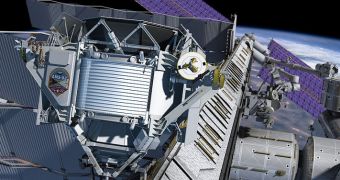The Alpha Magnetic Spectrometer-2 (AMS-02) experiment that will fly on space shuttle Endeavor in early 2011 has already begun collecting data for its mission, according to the instrument's principal investigator.
The scientific tool is to be taken to the International Space Station (ISS) by space shuttle Endeavor, during the orbiter's last planned mission, dubbed STS-134. The orbiter will take off in February 2011.
It will be job of MAS-02 to analyze the large amounts of cosmic rays making their way to the ISS, and determine whether the radiation contains exotic particles such as antimatter and/or dark matter.
The piece of hardware itself will be attached directly to the exterior of the ISS, and will require no additional extra-vehicular activity (EVA) to install.
The spectrometer will be the largest scientific instrument ever to be installed on the ISS, and, if everything goes as planned, it will give scientists much more information about the origin and the structure of the Universe/
It will also analyze cosmic radiation sources on stars and galaxies millions of years away from our Milky Way, so physicists and astronomers will be eagerly waiting for those information as well.
This February, the AMS-02 was tested for space travel compliance at the European Space Research and Technology Center (ESTEC) in Noordwijk, the (Netherlands, and then returned to CERN for final modifications.
The main change was the replacement of its superconducting magnet with a permanent magnet from the AMS-01 prototype, that had already flown into space in 1998. This happened because of a glitch that hampered the functionality of the first magnet.
Initially, Endeavor was supposed to fly earlier this year, and not in 2011. The delay was caused by the fact that the AMS-02 instrument had to be redesigned and rebuilt, with only parts of its original functionality still in place.
The presence of dark matter is revealed through its gravitational effect on regular matter, physicists say. The stuff does not readily interact with normal matter, but does exert its influence via gravity.
Dark matter can also be used to explain the cosmic phenomenon called gravitational lensing, in which the enormous mass of a galaxy cluster acts on the light from galaxies behind it like a cosmic magnifying glass.
This results in the bending the trajectory of the light, which makes the the galaxies in the background appear slightly distorted, experts say.
By observing and analyzing the twisted shapes of these background galaxies, astronomers can infer the total mass of the cluster responsible for the distortion, even when this mass is mostly invisible.
However, this effect is usually tiny, and it is necessary to measure it over a huge number of galaxies to obtain significant results, Universe Today reports.

 14 DAY TRIAL //
14 DAY TRIAL //